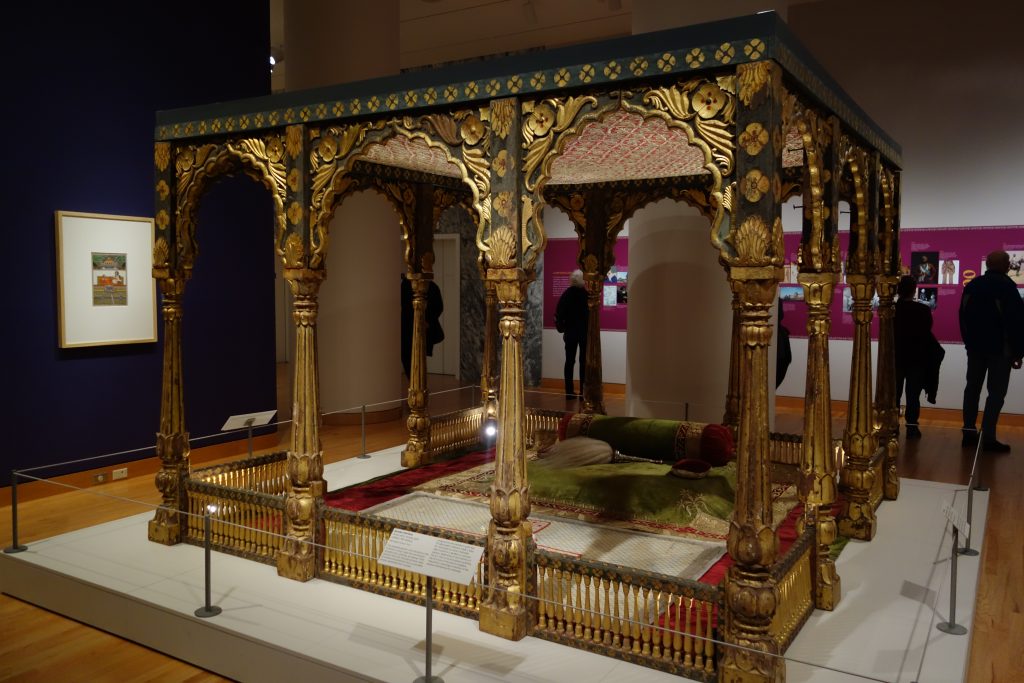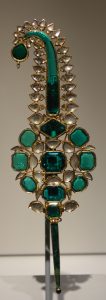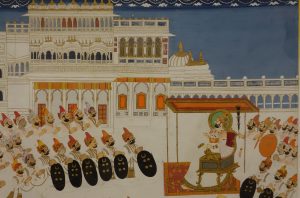
With the alluring name of Peacock in the Desert, an exhibit at the Seattle Art Museum (SAM) is showcasing the royal arts of Jodhpur, in the northwest of India.
It is said the colourful clothing worn by the women of Jodhpur stems from them wanting to emulate the glory of the desert which blooms when the monsoon drenches the parched land. The first thing that confronts a visitor to the exhibit is a recreation of a wedding procession, complete with a full-sized model of an elephant. It bodes well for the full exhibit, on the floor above.
Here you can get a real feel for what royal life was like for the maharajahs of the past. This exhibit is courtesy of the current Maharaja, GajSingh II, who established a museum trust in 1972. Portions of his vast collection were previously on exhibit in Seattle a decade ago. The seat of all this wealth and power is Umaid Bhawan Palace, one of the largest residences in the world, completed in 1943. It is now a major tourist attraction; a large model of it is on display in the SAM. You can actually stay in the palace, as part of it is now a hotel, recently given an award as the world’s best hotel (the maharaja room is only $7,000 a night).

This display features 250 objects ranging from small weapons to huge tents. Not surprisingly the jewelled items get the most attention. Just one of the large emeralds and rubies on display would tax the budget of a millionaire, but here we see items covered in dozens of them. From 1625 is an extraordinary dagger embellished with rubies, emeralds and diamonds. A turban ornament, also from the 17th century, consists of emeralds set in a such a way that when worn, the sun shines through them to create a dazzling effect (it is termed the a jour setting). This is made possible by the kundan technique, whereby gemstones are set with several layers of thin gold foil, allowing the stone to be fixed without heating.
Several paintings depict durbars, which became famous throughout England when royal durbars were held for the British monarch, who was head of state of India. An elaborate chair from the 1911 durbar in Delhi attended by King George V is on display. The ceremony goes back centuries, and was revived in 1707 when a maharaja of the Rathore family won back his ancestral kingdom from the declining Mughals. They invested heavily in the arts, from which springs most of the artifacts on display here. The durbar was an arena where the maharaja’s majesty and his noblemen’s loyalty are put on spectacular display. The depiction shown here comes from 1830, where the maharaja, under a canopy, raises his right hand to bestow blessings on his supporters.

The role of women is given special prominence in the exhibit. A wooden pavilion, decorated in gold and shown here, dates from the 19th century. It was in such elaborate small spaces that royal men and women enjoyed music, drank, and played board games. On the floor of the pavilion is a small ivory mat, more than 300 years old, on which is placed a board game. The structure of the pavilion appears frequently in paintings of women of the zerana, that is, those who were guarded by eunuchs and lived at court but were kept from the gaze of the populace. Today it is far different, as the queen and princess of Jodhpur now hold traditional festivals with the public.
I spent several hours touring this exhibit and also the permanent collection of SAM, which holds many wonderful paintings by such great artists as Van Dyck, Veronese and Rubens. So even if you can’t get there before the Jodhpur exhibit ends, no visit to Seattle is complete without a visit to SAM.
Peacock in the Desert ends its run at SAM on Jan. 21, 2019. Get tickets at visitsam.org/peacock
